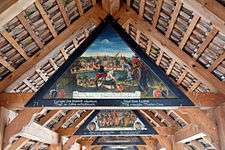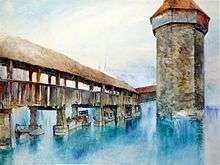Kapellbrücke
| Kapellbrücke | |
| Covered Wooden Footbridge | |
| The Kapellbrücke in Lucerne with its Wasserturm (water tower) seen in the middle. | |
| Name origin: Named after St. Peter's Chapel.[1] | |
| Country | Switzerland |
|---|---|
| Canton | Lucerne |
| River | Reuss |
| Location | Lucerne |
| - elevation | 438 m (1,437 ft) |
| - coordinates | 47°03′06″N 8°18′27″E / 47.05167°N 8.30750°ECoordinates: 47°03′06″N 8°18′27″E / 47.05167°N 8.30750°E |
| Length | 170 m (558 ft), north-south |
| Built | 1333 |
| - Destroyed by fire | August 18, 1993 |
| - Rebuilt | April 14, 1994 |

The Kapellbrücke (literally, Chapel Bridge) is a covered wooden footbridge spanning diagonally across the Reuss River in the city of Lucerne in central Switzerland. Named after the nearby St. Peter's Chapel,[1] the bridge is unique because it contains a number of interior paintings dating back to the 17th century, although many of them were destroyed along with most of the centuries-old bridge in a 1993 fire. Subsequently restored, the Kapellbrücke is the oldest wooden covered bridge in Europe,[2] as well as the world's oldest surviving truss bridge.[3] It serves as the city's symbol and as one of Switzerland's main tourist attractions.[4]
History

As part of the bridge complex, the Kapellbrücke includes the octagonal 140 ft (43 m) tall Wasserturm,[5] which literally translates to "water tower". However, the tower is not a water tower in the usual sense, but the name comes from the fact that the tower is standing in the water. The tower predated the bridge by about 30 years. Throughout the centuries, the tower was variably used as a prison, torture chamber, and later a municipal archive.[6] Today, the tower is closed to the public, although it houses a local artillery association as well as a tourist gift shop.
The bridge itself was originally built in 1333 as part of Lucerne's fortifications. It linked the old town on the right bank of the Reuss to the new town on the left bank, securing the city from attack from the south (i.e. from the lake).[7] The bridge initially had a length of over 200 metres (660 ft), although due to numerous shortenings throughout the years and river bank replenishments, the bridge now totals only 170 metres (560 ft) in length.[6] It is the oldest surviving truss bridge in the world, consisting of strutted and triangulated trusses of moderate span, supported on piled trestles; as such, it is probably an evolution of the strutted bridge.[3]
The Kapellbrücke almost burned down on August 18, 1993, destroying two thirds of its interior paintings. Shortly thereafter, the Kapellbrücke was reconstructed and again opened to the public on April 14, 1994 for a total of US$2.1 million.[6]
Paintings
Lucerne is unique in the fact that its three wooden pedestrian bridges, the 14th century Hofbrücke (now destroyed) and Kapellbrücke and the 16th century Spreuerbrücke, all featured painted interior triangular frames. This feature is not replicated in any of Europe's other wooden footbridges.[7] The paintings, dating back to the 17th century by local Catholic painter Hans Heinrich Wägmann, depict events from Lucerne's history. Out of the original 158 paintings, a total of 147 existed before the 1993 fire.[7] After the fire, the remains of 47 paintings were collected, although only 30 were ultimately fully restored.[7]
The wooden boards upon which the paintings were painted on were from 150 centimetres (59 in) to 181 centimetres (71 in) wide and 85 centimetres (33 in) to 95 centimetres (37 in) wide. Most of the panels were made from spruce wood boards, while only a few were made from linden wood and maple. The paintings were created during the time of the Counter-Reformation, featuring scenes promoting the Catholic Church. The paintings themselves were sponsored by the city's council members, who upon sponsoring a panel, were allowed to attribute their personal coat of arms on it. An explanation of each painting was printed below each scene. The paintings ran all along the bridge, dating from the life and death of Lucerne's patron saint St. Leger to the legends of the city's other patron saint St. Maurice.
References
- 1 2 "Chapel Bridge". Official Website of Lucerne Tourism. Luzern Tourismus AG. Retrieved 8 July 2011.
- ↑ Reinle, Adolf (1953). Die Stadt Luzern, Teil 1. (in German). Basel: Birkhäuser Verlag. p. 75.
- 1 2 Lay, M. G. (1999). Ways of the World: A History of the World's Roads and of the Vehicles That Used Them. Rutgers University Press. p. 266. ISBN 978-0-8135-2691-1.
- ↑ "Chapel Bridge (Kapellbrucke)". Viator.com. Retrieved 8 July 2011.
- ↑ Dossenbach, Frederick (1923). How to see Switzerland: a practical guide. Forgotten Books. p. 195. ISBN 1-4400-4894-0.
- 1 2 3 Porter, Darwin (2010). Frommer's Switzerland. Frommer's. p. 362. ISBN 0-470-54125-3.
- 1 2 3 4 "Die Bilder der Kapellbrücke". Official Website of Lucerne Tourism (in German). Luzern Tourismus AG. Retrieved 9 July 2011.
External links
-
 Media related to Kapellbrücke at Wikimedia Commons
Media related to Kapellbrücke at Wikimedia Commons - Kapellbrücke at Structurae
- Kapellbrücke at Structurae
- Virtual tour 360° of Chapel Bridge.